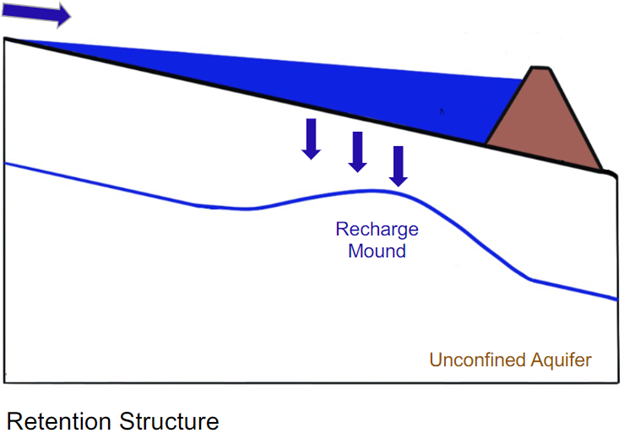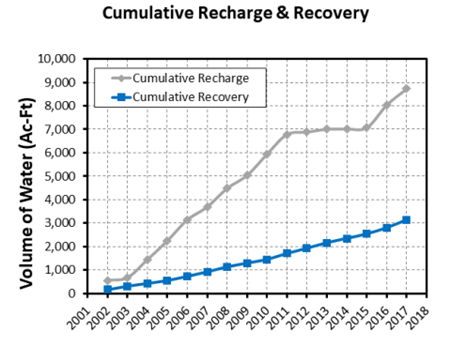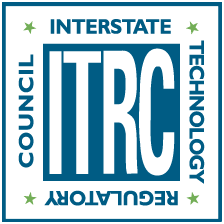Introduction
Retention structures are often critical components for development of a managed aquifer recharge (MAR) program or portfolio that relies on several MAR projects and technologies. Aquifer recharge retention structures (see figure below) are typically impoundments, built along natural runoff channels or, in some cases, in the form of channel structures, which are designed to percolate water to recharge the aquifer. The goal of such structures is to route surface water to where recharge is needed most and slow the flow of surface water to maximize capture of source water for recharge within watersheds (for example, to augment baseflow in stream channels for ecosystem resilience).
A retention structure is usually a dam (dike, levee, embankment) that captures surface water (stream) flow or storm runoff to maximize the amount of water that is recharged (at the expense of less surface water flow downstream). Rubber inflatable dams can also be used as retention structures. Weirs can be a component of such retention structures and can be constructed upstream of the dam and at the spillway to measure inflow and outflows. Retention ponds are typically small (usually less than 5 acres) but may be placed in series to increase system capacity.

Figure 1 provides an example of a retention structure MAR program for the Orange County Water District’s (OCWD) Surface Recharge system.

Figure 1. Schematic of diversion (shown by arrows) and retention structures in MAR program for Orange County Water District’s Surface Recharge system.
Source: OCWD (2021)
Other examples of emerging diversion and retention structure surface recharge technologies include the following pilot programs in California:
- Agricultural Flood-MAR is a recent development that is being pilot-tested in California. It involves flooding farmland to replenish aquifers—for example, Merced Irrigation District’s Mariposa Creek Flood-MAR pilot project. The geochemical processes and potential water quality benefits and concerns are being studied (Levintal et al. 2023).
- The Recharge Net Metering (ReNeM) concept (Kiparsky, M. et al. 2018) to incentivize groundwater recharge is being tested with a pilot program initiated in Pajaro Valley, Santa Cruz County (Miller, Fisher, and Kiparsky 2021). The goal of ReNeM is to give farmers monetary incentives to augment stormwater capture for recharge in return for receiving pumping credits against their groundwater pumping fees balance. In an abstract sense, this concept is similar to issuing carbon storage credits for CO2 emitters that practice carbon sequestration (injection).
Applicability
Retention structures used in recharging aquifers have the following objectives:
- maintain or augment groundwater levels in the aquifer
- conserve available surface water (storm flow) by transferring it to subsurface storage
- reduce the impact of downstream flooding by altering the storm flow-base flow balance within a watershed
- augment spring flow, which also enhances flow in spring-fed streams
- enhance streamflow during seasonal dry periods or in response to drought or climate alterations
- maintain minimal in-stream flows to protect endangered aquatic species and/or riparian ecosystems
- combat saltwater intrusion by using recharge to create and maintain a flow boundary, or hydraulic barrier, between the intruding saltwater and the freshwater aquifer
Recharge structures should be planned after proper hydrogeologic investigations are carried out for selection of the recharge site and design of the structure. These investigations should include:
- characterize subsurface geology
- determine the presence or absence of impermeable layers that may impede infiltration
- determine the amount of drainage area that will flow into the structure and calculate storage
- determine the depth to the water table and groundwater flow direction
- calculate the maximum rate of recharge that can be achieved at the site
- evaluate water quality to ensure groundwater geochemical compatibility
- evaluate benefit/cost considerations
Advantages
Advantages of retention structure MAR technologies include:
- reducing the peak flow rate and cumulative volume of flood flows to retain more surface water for recharge, while reducing the risk of flooding and/or amount of water lost downstream (for example, to an ocean)
- allowing suspended solids to settle out, improving water quality, and reducing the clogging potential before conveyance to a recharge facility
- lower capital costs to build temporary retention structures (for example, rubber dams) than permanent retention structures (for example, earth/concrete dams or infiltration basins)
Limitations
Limitations of diversion and retention structure MAR technologies include:
- The aquifer needs to be unconfined and without significant impermeable layers so that surface water can infiltrate into the subsurface.
- Not every unconfined aquifer is conducive to the use of retention structures (for example, shallow aquifers with high water tables do not have much recharge capacity).
- Retention structures need to be located at strategic locations along channels, depending on the local physiography.
- In the case of agricultural Flood-MAR, the land may be unsuitable for desired infiltration rates (resulting in excessive ponded conditions that may damage crops) and/or the land may be impacted with salts, pesticides, and/or herbicides that could leach and contaminate the target aquifer.
- Placing a retention structure in an existing stream/river channel may present a constraint for flood control. The project may need to work with local flood control districts and potentially the U.S. Army Corps of Engineers (USACE). In coastal streams, there could be issues with the U.S. Fish and Wildlife Service (USFWS) and National Marine Fisheries Service (NMFS).
Performance
It is important that MAR projects are evaluated with objective and quantitative metrics to minimize ambiguity in how success is defined and evaluated (Maliva 2020; Maliva and Missimer 2010). Like other recharge technologies, the performance of diversion and retention structures is typically measured and monitored using volumetric measures (for example, recharge and recovery rates and volumes) and evaluated with economic metrics (for example, cost/volume and benefit/cost ratio).
Examples of volumetric performance metrics include recharge rates associated with diversion and retention structures used by OCWD along the water district’s 6-mile portion of the Santa Ana River, which is at the core of the water district’s MAR program and can recharge up to 65 mgd of water (OCWD 2021). When it comes to a comparison of recharge and recovery volumes, Figure 2 shows an example comparison of cumulative recharge volumes associated with a retention structure (for example, an infiltration basin) (Pajaro Valley Water Management Agency 2018).

Figure 2. Example comparison of cumulative recharge and recovery volumes over time.
Source: Modified from Figure 15 of Pajaro Valley Water Management Agency (2018)
Examples of economic performance metrics in Ross (2022) show the advantages of MAR based on the benefit/cost ratio of several MAR programs across the globe. The Idaho Eastern Snake Plain aquifer has demonstrated low costs since 2014, accounting for capital cost; conveyance fees; and operation, maintenance, and monitoring costs (Hipke, Thomas, and Stewart-Maddox 2022).
Regulatory Considerations
Retention structures, especially if streamflows or streambeds are modified, typically require some type of permitting through state and federal regulatory agencies including:
- federal agencies with oversight of dams and flood control infrastructure (for example, Federal Emergency Management Agency (FEMA), Federal Energy Regulatory Commission (FERC), USACE, U.S. Bureau of Reclamation (USBR)) and/or environmental (for example, USEPA, USFWS, and NMFS) regulations
- state agencies with oversight of water rights and quality (for example, the California State Water Resources Control Boards (SWRCB), or New Jersey, which requires several permits, such as flood hazard area and wetland permits for dam diversion structures)
- local governments (for example, an adjudicated basin watermaster or special district)
Stakeholder Considerations
Various types of stakeholders that are typically involved with MAR projects span the private and public sectors, namely owners, operators, regulators, ratepayers, consultants, academics, and environmental agencies. Stakeholders that provide financial support for retention and diversion technology expect to get cost-effective benefits from MAR programs. Ideally, retention and diversion structures result in stable water supplies and project costs, especially in the face of climate uncertainty. Collaboration among the various types of stakeholders is ideal for addressing complex water resource management issues.
Regulatory stakeholders are primarily concerned with public safety. Examples include the USACE’s role in ensuring flood control, and federal and state agencies’ roles in regulating water quality for the protection of human consumption and ecological habitat. When it comes to diverting and retaining water, it is important for MAR program sponsors to be mindful of environmental stakeholders regarding ecologically sensitive habitat (for example, flora and fauna) that are subject to the Endangered Species Act. Adverse impacts to aquatic habitat and fish are often mitigated by installing fish screens and ladders, as well as substantial permit fees.
Collaboration among stakeholders on MAR programs can be critical for achieving sustainable water supplies. For example, projects sponsored by the Los Angeles Department of Water and Power (LADWP) and the Water Replenishment District (WRD) in Los Angeles County, California, are investing in recharge and recovery technologies to improve water supply resilience by reducing reliance on imported surface water supplies (from hundreds of miles away in Northern California and the Colorado River) and impacts to stakeholders in regard to uncertainty of future climate conditions.
Lessons Learned
Examples of lessons learned regarding retention and diversion recharge technologies, include:
- It is important for buyers and sellers of retention and diversion infrastructure, spanning private and public sectors, to participate in water banking projects as part of water markets (Ayers et al. 2021).
- There are potential impacts to environmental stakeholders due to diversion of surface water flows from navigable waters of the United States (for example, the interpretation of the Public Trust Doctrine by the NMFS).
- Collaboration among stakeholders helps realize mutual benefits. For example, federal agencies (for example, USACE and USBR) have been partnering with academic institutions (for example, the Scripps Institute of Oceanography) and water agencies (for example, OCWD and Sonoma Water) to develop Forecast Informed Reservoir Operations programs to optimize groundwater recharge, flood control, and protection of ecologically sensitive habitat.
- Pilot programs help stakeholders understand the advantages and limitations of emerging recharge technologies (for example, water markets, on-farm recharge, and ReNeM).
Case Studies (FS-2)
- Southern Idaho—Eastern Snake Plain Aquifer Recharge Program (see Case Study 5.6)
- Orange County, California—Orange County Water District’s (OCWD) Groundwater Replenishment System—Groundwater Recharge to Address Seawater Intrusion and Supply in an Urban Coastal Aquifer | Case Studies in the Environment | University of California Press (ucpress.edu)
- Santa Cruz County, California—Pajaro Valley Water’s Watsonville Slough System Managed Aquifer Recharge and Recovery Projects (https://www.pvwater.org/wss-marr) in the Pajaro Valley of Santa Cruz County, California
- Santa Cruz County, California—Pajaro Valley Water’s Coastal Distribution System (https://www.pvwater.org/the-coastal-distribution-system)
- Santa Cruz County, California—Pajaro Valley Water’s Recharge Net Metering (ReNeM) pilot program (Incentivizing Groundwater Recharge in the Pajaro Valley Through Recharge Net Metering (ReNeM) | Case Studies in the Environment | University of California Press (ucpress.edu))
- Merced, California—Merced Irrigation District’s Mariposa Creek Flood-MAR pilot project State Agencies Fast-track Groundwater Recharge Pilot Project to Capture California Flood Waters for Underground Storage—Multiple Landowners Can Divert Excess Flows from Mariposa Creek Near the City of Merced to Recharge a Key Groundwater Basin (goldrushcam.com)


